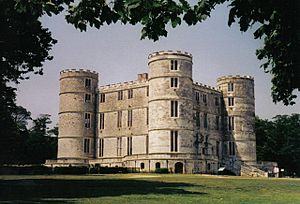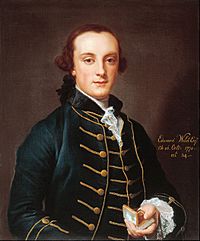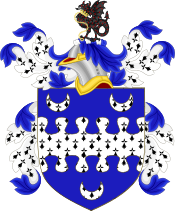Weld family facts for kids
The Weld family is a very old English family. They might also be connected to a large family in New England, USA, especially in Boston. One of the earliest Welds known to hold a public job was William, who was the High Sheriff of London in 1352.
In the 1500s and 1600s, Welds from Cheshire, England, started moving to other parts of England like London, Shropshire, Suffolk, and Dorset. Some even traveled across the ocean to the American Colonies. Most Welds in England became Protestant, but the three sons of Sir John Weld of Edmonton married into important families who kept their Roman Catholicism. Because of this, their children and later family members also remained Catholic. The famous Catholic Weld family line, which still exists today, is from Lulworth Castle in Dorset.
Contents
London Welds
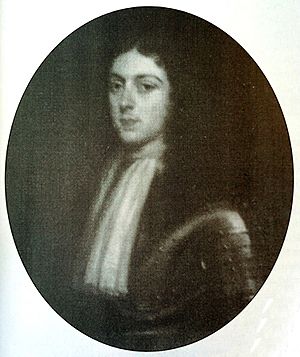
The Welds are an old noble family. They say they are related to Eadric the Wild, a famous English leader from long ago. There are Weld family branches in different parts of the United Kingdom, like Willey, Shropshire, and the Lulworth Estate in Dorset. Other branches are in Australia and the USA.
An important early Weld was William de Welde, who was the High Sheriff of London in 1352. His family had times when they were well-known and times when they were less so.
In the mid-1500s, a branch of the family started with John Weld of Eaton, Cheshire. His youngest son, Sir Humphrey Weld (who died in 1610), moved to Holdwell, Hertfordshire. He became a successful merchant in London and was part of the Worshipful Company of Grocers, a powerful trade group. In 1598, he was chosen as an alderman for London, which is like a city council member. He was also the Sheriff of London from 1599 to 1600 and was knighted in 1603. In 1608, he became the Lord Mayor of London, the city's highest leader. During his time as Mayor, the Aldgate, one of London's main gates, was rebuilt.
Humphrey Weld had two sons who survived. The older son was Sir John Weld (1585–1622) of Arnolds in Southgate. He was also a merchant and helped start the Newfoundland Company in 1610, which explored and settled lands in Canada. He also built the Weld Chapel in Edmonton, London. Sir John was knighted in 1617.
Sir John's sons married into important Catholic families and became recusants, meaning they secretly kept their Catholic faith when it was not allowed in England. Here are some of Sir John Weld's children:
- Humphrey Weld (1612–1685) was the second son and became the main heir. He studied law and traveled around Europe. He held many public jobs, like Deputy Lieutenant of Dorset and Justice of the peace. He was also a member of the House of Commons in 1661. Humphrey secretly remained Catholic to keep his public roles during a difficult time in English history. He worked for the Catholic Queen Henrietta Maria and later for Charles II. In 1641, Humphrey bought the huge Lulworth Estate in Dorset, which included Lulworth Castle. This started the Lulworth branch of the Weld family, which has continued for over 350 years.
- (Sir) John Weld (died 1674) lived in Compton Bassett, Wiltshire. His son, William Weld, later inherited from his uncle Humphrey.
- George Weld (died 1696) had two daughters.
The Welds of Lulworth
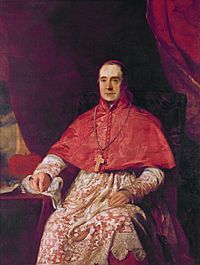
Edward Weld was the third son of Humphrey Weld (died 1722) of Lulworth. He took over the large estate in 1722. He was the fourth generation of Welds to manage the estate, which included part of the beautiful Jurassic Coast (now a UNESCO World Heritage Site). He improved the castle and its land. His oldest son, Edward Weld (1740–1775), took over next. He died young after a riding accident.
The next owner of Lulworth was Edward's younger brother:
- Thomas (1750–1810) loved books and gave a lot of money to good causes. He was a personal friend of King George III. He helped bring back Catholic education to England after the Reformation. He supported Stonyhurst College.
Thomas Weld and his wife, Mary Massey-Stanley, had fifteen children. Here are some of the notable ones:
- Thomas (born 1773) became a priest and a cardinal in the Roman Catholic church after his wife passed away.
- Joseph (born 1777) took over Lulworth Castle and the estates after his brother Thomas. He was known for building and sailing fast yachts. His most famous boat was The Arrow, which raced in the first America's Cup in 1851. Joseph also founded the Royal Yacht Squadron on the Isle of Wight.
- John (born 1780) became a Jesuit priest and leader at Stonyhurst.
- Mary Theresa (born 1784) became a nun.
- Clare (born 1788?) also became a nun.
Descendants
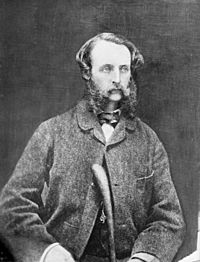
Many Welds continued to be important figures:
- Thomas Weld (1808–1887) inherited Lulworth. He added the name Blundell to his own.
- Sir Frederick Weld (1823–1891) was the Prime Minister of New Zealand and later the Governor of Western Australia.
- Alfred Weld (1823–1890) was a leading English Jesuit and astronomer. He was an important leader in the Society of Jesus and an author.
- Herbert Weld Blundell (1852–1935) was an English traveler, archaeologist, and yachtsman. In 1929, a fire badly damaged the inside of Lulworth Castle during his time as owner.
- Colonel Sir Joseph William Weld (1909–1992) was the Lord Lieutenant of Dorset. He became the owner of the Lulworth Estate and Lulworth Castle in 1935.
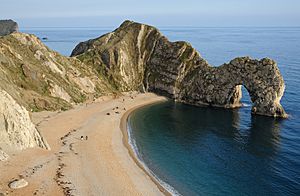
- Wilfrid Weld (1934–2015) was a Deputy Lieutenant of Dorset. He helped change the Lulworth Estate from a traditional estate into a modern business that relies on tourism and farming. Under his leadership, Lulworth Castle was restored, and Lulworth Cove and Durdle Door became famous places known around the world.
Willey Welds
John Weld, the second son of John Weld of Eaton Hall, settled in Shropshire and started the Willey Welds branch of the family. His son, John Weld (1582–1666), became the Town Clerk of London from 1613 to 1642. He bought the manor of Willey, Shropshire in 1617–1618 and was knighted in 1642.
MPs for Much Wenlock
The Welds had several members of their family serve as MPs for Much Wenlock, where they had businesses. This included George Weld and his father, Sir John Weld (died 1681). Later, George Weld the younger (1674–1748) also became an MP for Wenlock. His daughter, Elizabeth, married Brooke Forester, who also became a Wenlock MP.
Eventually, the Weld family line in Shropshire ended. However, the Weld name continued when Cecil Forester was allowed to add "Weld" to his name in 1811 to inherit the Willey estate. He became Baron Weld-Forester.
American Welds
The Weld family has been in Massachusetts, USA, since the early 1600s. Three sons of Edmund Weld (1559–1608) from Sudbury, Suffolk, England came to Boston. Daniel Weld (1585/1586–1666), the oldest, became a teacher.
Captain Joseph Weld (1599–1646), the youngest of the three brothers, is the ancestor of the richer and more famous American Welds. He was given land in Roxbury (now part of Jamaica Plain and Roslindale) for his part in the Pequot War of 1637. With the money from this land, Joseph Weld became one of the first people to donate to Harvard University and helped start the Ancient and Honorable Artillery Company of Massachusetts.
Connection with Harvard
The Weld family has been connected to Harvard for almost 400 years. The first Weld to attend Harvard, John Weld (born 1625), was expelled for stealing. He later returned to England and became a minister. Edmund Weld (1631–1668), the first Weld to graduate from Harvard (in 1650), also left Massachusetts and became a minister in Ireland.
Since then, at least eighteen more Weld family members have graduated from Harvard. Two important buildings at Harvard University are named after the family.
John Weld
Captain John Weld, son of Captain Joseph Weld, inherited his father's land. He built his home, Weld Hall, on what became known as Weld Hill in Forest Hills.
Later, descendants of John Weld created Weld Farm near Brookline. Other Welds developed land near Dedham. In the 1800s and 1900s, these Weld properties became very luxurious estates.
William Gordon Weld
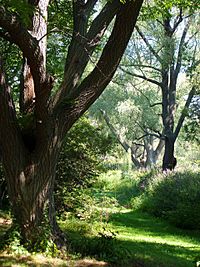
The first Weld Hall in Jamaica Plain was home to many generations of Welds. The last was Colonel Eleazer Weld, one of seven Weld family members who fought in the American Revolutionary War. George Washington even chose Weld Hill as a fallback point for the army if needed.
After Eleazer Weld died in 1800, much of his land went to Benjamin Bussey, who later gave it to Harvard. This land became the basis for Arnold Arboretum, a famous plant research center. In Roslindale, part of the arboretum is still called the "Weld-Walter tract." There's a small cemetery there with tombstones from the 1700s and 1800s, where two Welds who fought in the Revolutionary War are buried.
William Gordon Weld (1775–1825), Eleazer's fifth son, started a fleet of trading ships that brought great wealth from China. He had eight sons and one daughter. His sons had many descendants.
Issue
- William Fletcher Weld (1800–1881), son of William Gordon Weld, made his father's shipping business even bigger, creating a world-famous fleet of clipper ships. He also invested in railroads and city real estate.
- Stephen Minot Weld (1806–1867), another son of William Gordon Weld, was a teacher and real estate investor. After he died, his older brother built the Harvard dormitory known as Weld Hall in his honor.
- George Walker Weld (1840–1905), a son of William Fletcher Weld, helped start the Boston Athletic Association (which organizes the Boston Marathon). He also paid for the Weld Boathouse, a famous building on the Charles River.

- Isabel Weld Perkins (1876–1948) was a grandchild of William Fletcher Weld and inherited a lot of his money. She married diplomat Larz Anderson. Isabel believed her Weld family was the same as the Weld family of Lulworth Castle in England. So, she and Larz Anderson changed their house to look like parts of Lulworth Castle.
- Dr. Charles Goddard Weld (1857–1911), a son of William Fletcher Weld II, was a doctor and gave money to many causes. He bought Japanese art and gave it to the Boston Museum of Fine Arts, which now has one of the largest collections of Japanese art outside Japan.
- General Stephen Minot Weld Jr. (1842–1920), son of Stephen Minot Weld, was a brave general in the American Civil War, fighting in major battles like the Second Battle of Bull Run, Antietam, and Gettysburg.
- Francis Minot Weld Jr. founded the investment bank White Weld & Co. in the early 1900s.
- William Floyd "Bill" Weld is the grandson of Francis Minot Weld Jr. He later became the governor of Massachusetts. His first wife, Susan Roosevelt Weld, is a great-granddaughter of President Theodore Roosevelt.
- Susan Ker Weld, known as Tuesday Weld, is a famous actress who was nominated for an Academy Award. She is a distant cousin of William Weld.
Returning to Europe
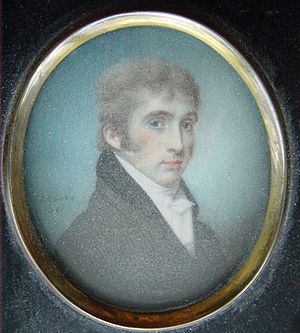
Isaac Weld (1774–1856) was an Irish writer, explorer, and artist. He was born in Dublin. Isaac and his sister, Esther, were possibly related to the Welds of Suffolk, England, who had moved to New England. Their ancestor, Thomas Welde, helped translate the Bay Psalm Book, the first book published in the American colonies. Thomas Welde later returned to England.
There were also other Welds in the 1800s who were descendants of Joseph's older brother Thomas and returned to England in 1641.
See also


